|
|
|
| My Favourite Planet > English >
People > Ancient Greek artists> Potters/vase painters E-H |
| MFP People |
Ancient Greek artists – page 8 |
 |
Page 8 of 14 |
 |
|
| |
| Potters / vase painters E - H |
| |
| E F G
H |
Potters and
vase painters |
E |
|
|
| |
Erichthonios Painter
Painter of red-figure vases in Athens, active around 450-420 BC.
Named by John Beazley after a red-figure pelike with a painting of the discovery of the infant Erichthonios (Ἐριχθόνιος), a mythical king of Athens. On side B are two draped ephebi (youths). 440-430 BC. Found in grave 74 of the ancient cemetery at Fikellura, near the site of the city of Kamiros, western Rhodes. British Museum, London. Inv. No. 1864,1007.125 (Vase E 372). Height: 26.67 cm, diameter 18 cm.
Another red-figure pelike attributed to the Erichthonios Painter, also found in a grave at one of the cemeteries of Kamiros, depicts the birth of Aphrodite (see photo below). Rhodes Archaeological Museum. Inv. no. 12454. |
|
|
| |
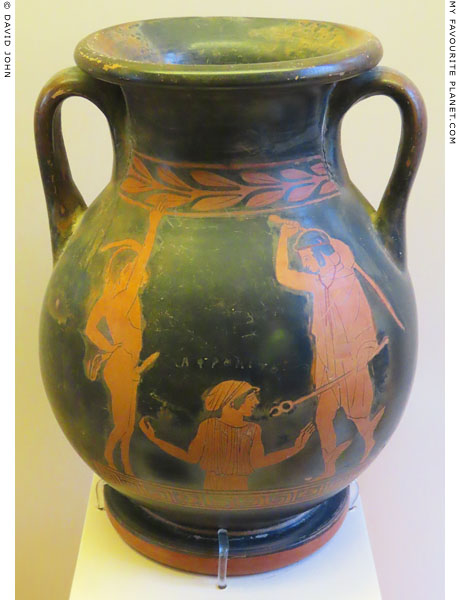
An Attic red-figure pelike attributed to the Erichthonios Painter,
with a depiction of the birth of Aphrodite as an anados (ἄνοδος,
ascent) from the earth. Her name Αφροδιτε is inscribed above
her head. To the left stands an ithyphallic Pan, and to the right
Hermes holding his kerykeion (caduceus). They are described as
flagellating themselves to make her rise.
On side B is a painting of two youths running.
From an inhumation burial of an adult, Macri Langoni T 26 (54).
450-420 BC. Found during excavations in the necropolis at Macri
Langoni, near Kamiros, Rhodes. Height 25.5 cm, diameter 12.5 cm.
Rhodes Archaeological Museum. Inv. no. 12454. |
| |
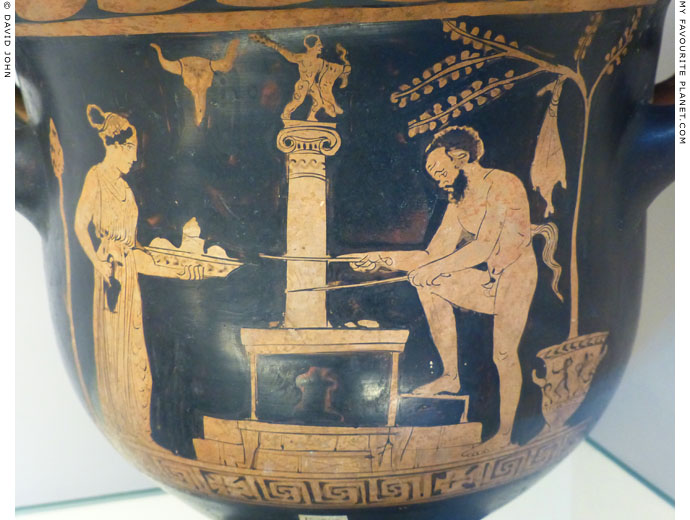
A Maenad and a Satyr, figures usually associated with Dionysus, at a rural shrine
of Herakles. In the background a statue of the hero stands on an Ionic column.
Detail of a red-figure bell krater (mixing bowl), made in Apulia, southern Italy,
around 380-360 BC. From Apulia. Attributed to the Eton-Nika Group.
British Museum. GR 1867.5-8.1327 (Vase E 505). From the Blacas Collection. |
| |
Eucharides Painter
Vase painter in Athens, active around 500-460 BC.
Perhaps a pupil of the Nikoxenos Painter.
Named by John Beazley after the signature of the potter Meidias inscribed on a hydria now in the British Museum, Vase E 224.
A variety of black-figure and red-figure vases, from large kraters to small cups, have been attributed to the Eucharides painter. His subjects were scenes from mythology and daily life. He painted number of Panathenaic prize amphoras, traditionally decorated in black-figure, and may have the first red-figure artist to have painted a number of them after 500BC.
A red-figure oichonoe depicting Nike at an altar by the Eucharides Painter. Around 490-480 BC. Agora Museum, Athens. Inv. No. P 15010.
A black-figure Panathenaic prize amphora, around 500-490 BC. Side A: Athena Promachos, with helmet, aegis, spear and shield, between two columns topped by cockerels. Side B: a horse race between two nude youths with long hair, each holding a three-thonged whip. British Museum. Inv. No. GR 1836,0224.193 (Vase B133). |
|
|
| |
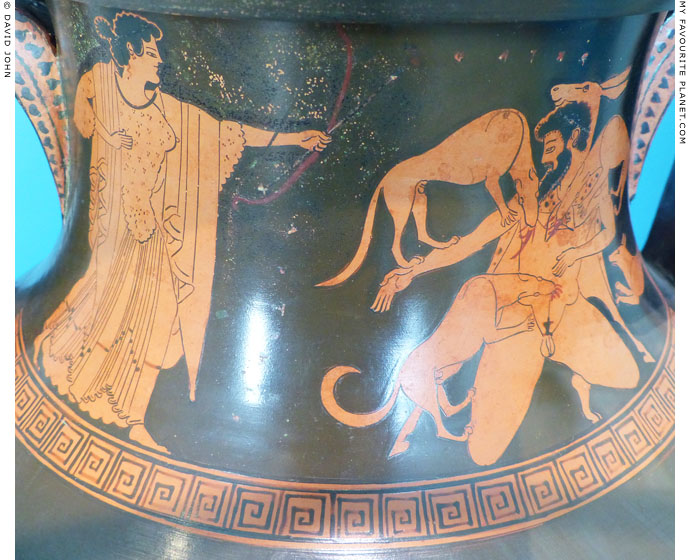
The neck of an Attic red-figure neck amphora with a painting of the hunter Actaeon,
transformed into a stag by Artemis (left with bow), being torn to pieces by his own
dogs as a punishment for spying on he goddess as she bathed.
Potter of the Berlin Amphora and the Eucharides Painter. 1st quarter of the 5th century BC.
Side B (not visible in museum display) shows Hermes killing the hundred eyed giant Argos,
the guardian of Io, a mistress of Zeus whom he had transformed into a heifer (see Hermes).
Museum für Kunst und Gewerbe Hamburg. Inv. No. 1966.34. |
| |
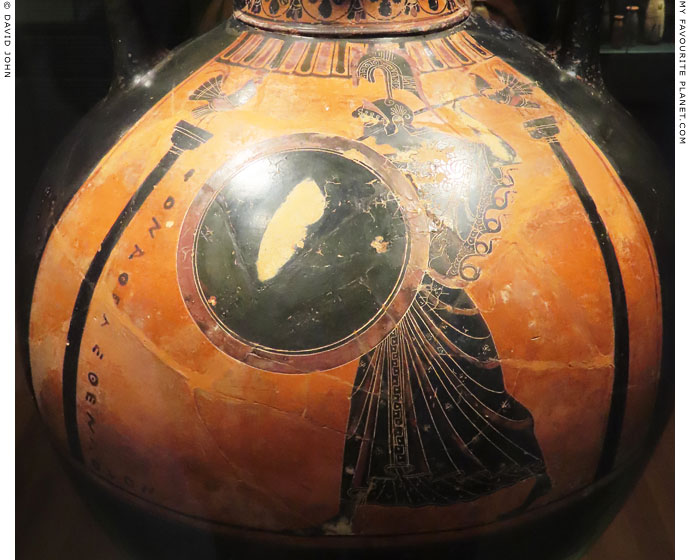
Athena on the body of an Attic black-figure Panathenaic prize amphora.
Attributed to the Euphiletos Painter, circa 530-520 BC.
Allard Pierson Museum, Amsterdam. Inv. No. 1897.
|
Panathenaic prize amphoras were containers for oil from a sacred grove of olive trees. The oil itself was the prize awarded to victors in contests of the Greater Panathenaia festival, held in Athens every four years. Winners received a specific amount of oil in a number of amphoras, on one side of which was a painting depicting the event in which they were victorious (see photo below). The form and decoration of these amphoras had become more or less standardized by around 530 BC, and the tradition of decorating them using the black-figure technique continued after the introduction of red-figure painting at the end of the same century.
Typically, as here, Athena the patron goddess of Athens is depicted in a panel on one side of the amphora's body. She is shown as the warlike Athean Promachos (Athena at the Forefront), striding to the left, wearing a high-crested Attic helmet and a snaked-fringed aegis over a long chiton. On her left arm she carries a round shield, and with her raised right arm she aims a spear. She is flanked by two tall Doric columns, on each of which stands a votive sculpture of a cockerel. Written vertically in mirrored letters to the right of the left-hand column is the inscription "Ton Athenethen athlon" ("One of the prizes from Athens").
The Euphiletos Painter is the earliest artist whose Panathenaic prize amphoras have survived in any number. They include one in the British Museum, Vase No. B 134, and another in the Antikensammlung Munich, Inv. No. 1453. Both were found in Vulci, Etruria (Lazio, Italy). |
|
|
| |
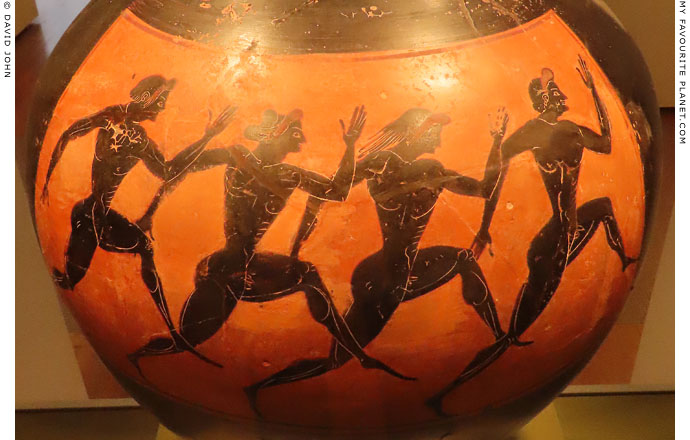
Four naked men running in a foot race on the other side of the
Panathenaic prize amphora by the Euphiletos Painter above.
Allard Pierson Museum, Amsterdam. Inv. No. 1897. |
| |
Euphronios
Εὐφρόνιος
Vase painter and potter in Athens,
active around 535 - after 470 BC.
Probably a pupil of Psiax.
He worked in the workshops of the potters Kachrylion, who produced drinking cups, and Euxitheos, but appears to have worked with other potters on other vase forms. He may have had his own workshop from around 500 BC.
Originally a painter of black-figure pottery, he became part of the Pioneer Group, the modern name given to a group of vase painters working aound 520-500 BC, who were involved in the shift from black-figure to red-figure pottery and the transition from Late Archaic to Early Classical art. The group also included the Dikaios Painter, Euthymides, Hypsias, Phintias, Smikros and the Sosias Painter. They were not the inventors of the red-figure technique, thought to have been first practised in the workshop of the potter Andokides around 530 BC, perhaps by the Andokides Painter or Psiax. Members of the group adopted the technique up to ten years after its invention, and Euphronios' earliest red-figure works are dated to around 520 BC.
He was one of the most important artists of the red-figure technique, and one of the first known artists to sign his work. His drawing style is clear, bold, precise and detailed, and his compositions monumental. He experimented with various painting styles and techniques. His subjects were scenes from Greek myths and daily life.
Around 27 mostly fragmentary black-figure and red-figure vases, including drinking cups, kraters and amphoras, have been attributed to Euphronios. Of these, he signed six egraphsen (ἔγραφσεν, painted it) and twelve epoiesen (έποίησεν, made it). The latter, all cups, are thought to have been from later in his career. They were painted by a number of artists, including Douris and Makron, but mostly by Onesimos.
His finest work is considered to be the "Euphronios krater" (or "Sarpedon krater"), a red-figured calyx-krater dated around 515 BC, signed by Euxitheos as potter and Euphronios as painter. Height 45.7 cm, diameter 55.1 cm. It is the only vase by Euphronios to have survived complete.
Side A shows the death of the Homeric hero Sarpedon, son of Zeus and king of Lycia, who was killed by Patrocles during the Trojan War. Hermes directs Hypnos (Sleep) and Thanatos (Death) who carry Sarpedon's corpse after it has been rescued by Phoebus Apollo. On side B, three young Athenians put on their armour before battle.
Looted by grave robbers from an Etruscan tomb near Cerveteri, Italy (ancient Caere, Etruria) in 1971. Formerly in the Metropolitan Museum of Art, New York (Inv. No. 1972.11.10), it was returned to Italy in 2008. First moved to the National Etruscan Museum, Villa Giulia, Rome (Inv. No. L.2006.10), it is now in the National Archaeological Museum of Cerveteri.
Beazley Archive Database, Vase No. 187
See a fragment of a black-figure Attic krater with the head of Herakles, attributed to Euphronios, below. |
|
|
| |
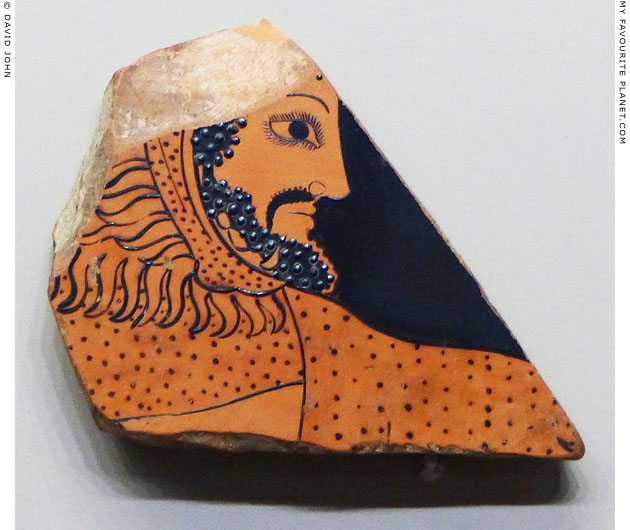
Fragment of a red-figure Attic krater with the head
of Herakles wearing the skin of the Nemean Lion.
Attributed to Euphronios, circa 510-500 BC. Distance between left
angle of the eye and the point of the beard 7 cm. Thickness 7-8 cm.
Provenance unknown. It may have belonged to the Milanese lawyer
and historian Emilio Seletti (1830-1913), who donated most of his
collection to the Musei Civici of Milan at the end of the 1900s.
Civic Archaeological Museum, Milan. Inv. No. A 0.9.1810.
See:
Gian Guido Belloni (1919-1996), A Fragment of Euphronios in the Musei Civici in Milan.
American Journal of Archaeology, Volume 54, No. 2 (April - June 1950), pages 119-120. At jstor.
Beazley Archive Database, Vase No. 200067 |
| |
Exekias
Ἐξηκίας (signature ΕΧΣΕΚΙΑΣ, Exsekias)
Potter and painter in Athens, active around 550-525 BC
He taught the Andokides Painter, who with Psiax, is among those credited with the invention of red-figure painting around 530 BC.
Exekias is considered to be the best black-figure painter. His signature as painter and potter has been found on two vases, and another ten as potter only. Around 32 vases (some now only fragments) are attributed to him.
See further information and
photos on the Exekias page. |
|
|
| |
Potters and
vase painters |
F |
|
 |
|
| |
Foundry Painter
Vase painter in Athens,
active around 500-470 BC.
He worked in the workshop of the potter Brygos, and specialized in cups. He also worked with Onesimos, Euphronios and the Brygos Painter.
The Foundry Painter is named after the "Berlin Foundry Cup" (German, Erzgießerei-Schale), an Attic red-figure kylix (drinking cup), made in Athens 490-480 BC. The outside (Sides A and B) shows men making sculptures at a bronze foundry (see below). The tondo (round painted panel) on the inside depicts Hephaistos giving Thetis the armour he has made for her son Achilles during the Trojan War. Berlin State Museums (SMB). Currently in the Altes Museum. Inv. No. F 2294. |
|
|
| |
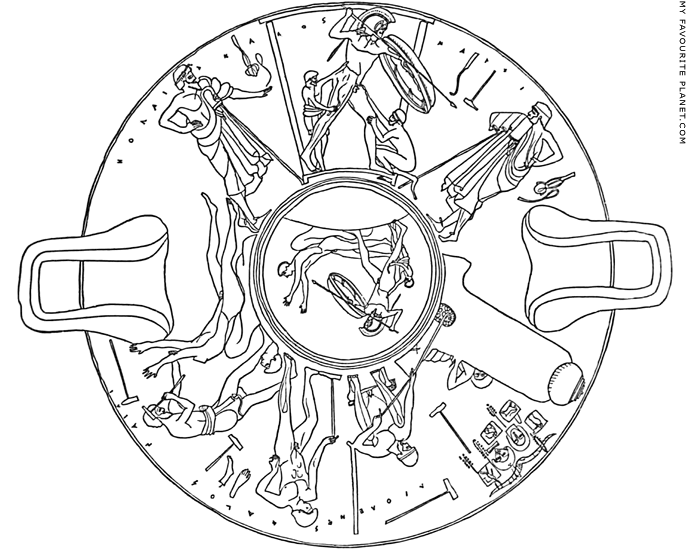
Workers (sculptors) finishing a bronze statue group at a foundry.
A drawing of the outside (Sides A and B) of the "Berlin Foundry Cup",
an Attic red-figure kylix (drinking cup), made in Athens 490-480 BC.
The name vase of the Foundry Painter. Diameter 30.5 cm.
The finished group, an armed warrior standing over a fallen man,
is painted beneath the foot of the kylix. The tondo on the inside
of the cup depicts Hephaistos giving Thetis the armour he has
made for her son Achilles during the Trojan War.
Altes Museum, Berlin. Inv. No. F 2294.
Image source: Alexander Stuart Murray, A history of Greek sculpture, Volume 1
(of 2), frontispiece. John Murray, London, 1890. At the Internet Archive. |
| |
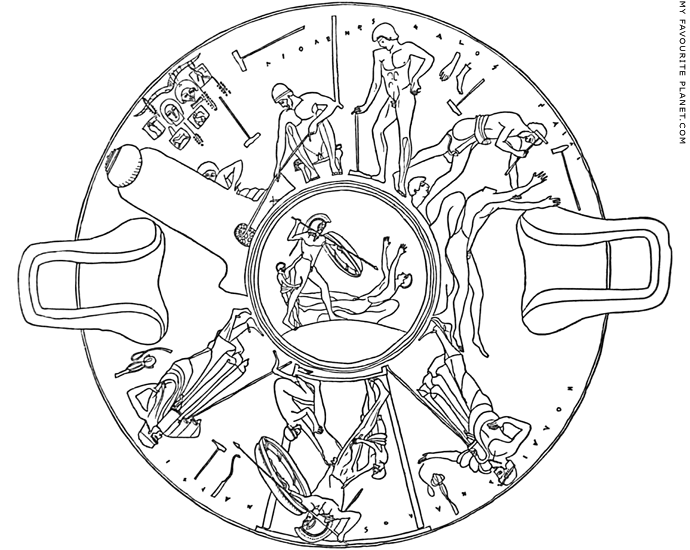
The drawing of the outside of the "Berlin Foundry Cup" turned 180 degrees. |
| |
Potters and
vase painters |
G |
|
 |
|
| |
Gela Painter
Black-figure vase painter in Athens, active around 500-450 BC.
Most of the vase paintings attributed to the Gela Painter are on lekythoi (small funerary vases), found in Italy (Magna Graecia, or West Greece), and particularly in Sicily, to where they had been exported from Athens. His real name is unknown; he is named after the ancient Greek colony Gela, on the south coast of Sicily, where many of his works have been discovered.
Images by this prolific but "undistinguished" painter, mainly mythological and genre scenes, are original but executed in a loose, "careless" manner.
Herakles and Apollo struggle for the Delphic tripod on an Attic black-figure lekythos attributed to the Gela Painter, circa 520 BC (see photo below). From Akragas (Agrigento), Sicily. Agrigento Regional Archaeological Museum. Inv. No. R 146.
A black-figure lekythos by the Gela Painter with a fountain scene. From the Athenian Agora. Circa 500 BC. Agora Museum, Athens. Inv. No. P 24106. |
|
|
| |
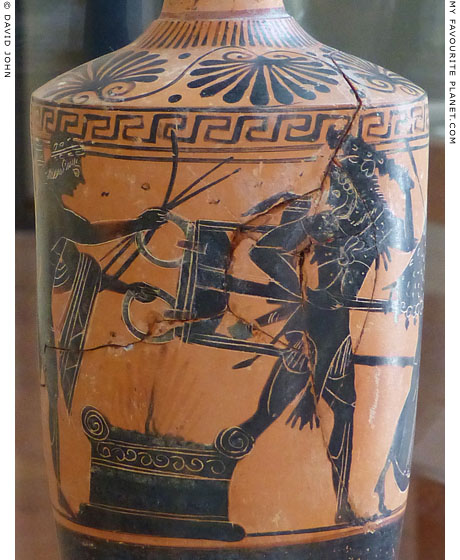
Herakles and Apollo struggle for the Delphic tripod over a flaming altar.
Detail of an Attic black-figure lekythos, attributed to the Gela Painter,
circa 520 BC. From Akragas (Agrigento), Sicily.
Agrigento Regional Archaeological Museum. Inv. No. R 146.
|
Apollo, wearing a laurel wreath, a chamlys and a quiver over his shoulder, and carrying a bow and arrows, holds onto two rings on the top of the Delphic tripod as Herakles attempts to escape with it to the right. Herakles, wearing a lion skin, a quiver and a scabbard, carries the tripod by one of its leg with his right hand, while with his left hand he raises his club threateningly. Between the two figures is the inscription NO NO.
Behind Apollo (not visible in the photo) stands a bearded male figure (Ares?), wearing a himation and holding a double javelin. Athena, with helmet, shield and spear, stands in front of Herakles (to the right). On the other side of the vessel is a Doric column. |
|
|
| |
Potters and
vase painters |
H |
|
 |
|
| |
Hermonax
Ἑρμῶναξ
Red-figure vase painter in Athens,
active around 470-440 BC.
Probably a pupil of the Berlin Painter with the Achilles Painter, and a contemporary of the Providence Painter.
Over 150 vases have been attributed to him, including 10 signed "Hermonax has painted it". He mainly painted large vessels, including pelikai and stamnoi, but also lekythoi and some cups. Many of his surviving works depict Dionysiac themes.
Among the many vases and fragments in museums and collections is a red-figure krater depicting a fighting Centaur, now in the Civic Archaeological Museum, Milan. Inv. No. A 0.9.8024. |
|
|
| |

The Ancient Greek alphabet painted on each side of a kylix
(κύλιξ, drinking cup). Unknown provenance. About 420 BC.
National Archaeological Museum, Athens. Vase collection. Inv. No. 9716. |
| Photos and articles © David John, except where otherwise specified. |
 |
Visit the My Favourite Planet Group on Facebook.
Join the group, write a message or comment,
post photos and videos, start a discussion... |
|
|
| |
|
|
| |
| |
 |
| |
 |
| |
 |
| |
 |
| |
 |
| |
 |
| |
George Alvanos
rooms in
Kavala's historic Panagia District
Anthemiou 35,
Kavala, Greece
kavalarooms.gr
|
| |
Olive Garden Restaurant
Kastellorizo,
Greece
+30 22460 49 109
kastellorizo.de
|
| |
Papoutsis
Travel Agency
Kastellorizo,
Greece
+30 22460 49 286
greeklodgings.gr
|
| |
|